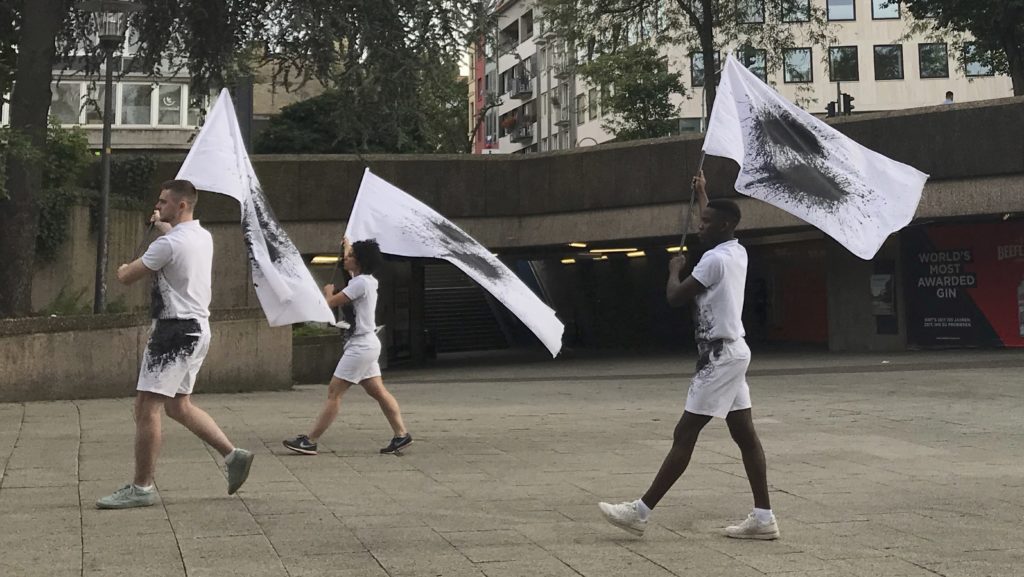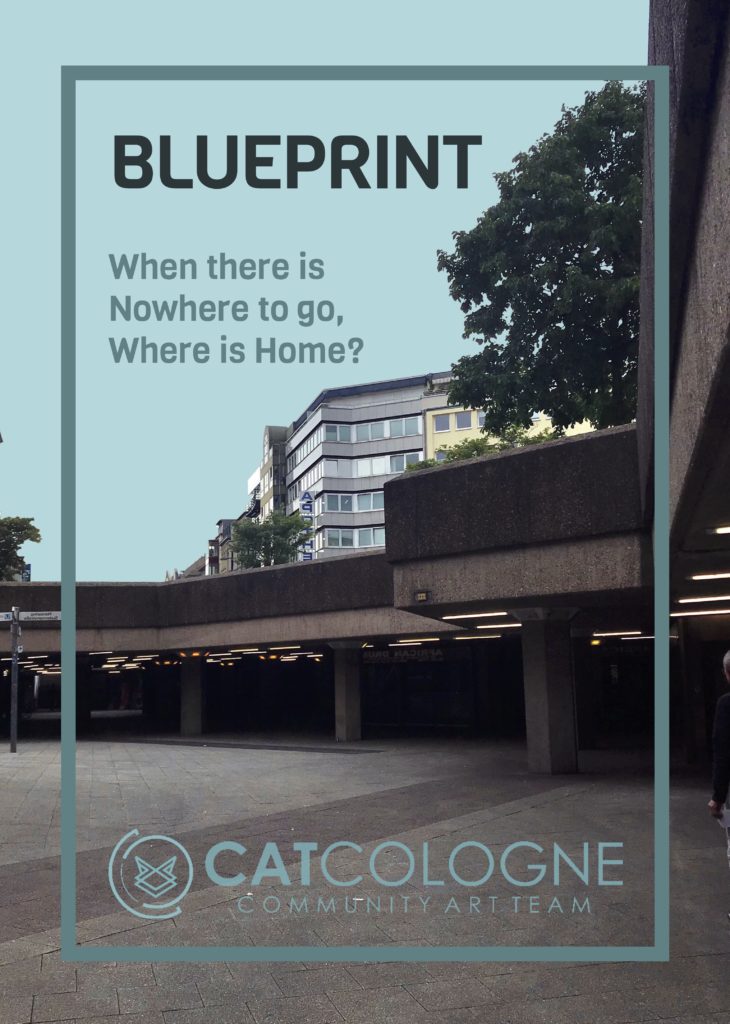As Part of BLUEPRINT
Public Interventions Curated by Khanyisile Mbongwa
CAT e.V. Cologne
June 23, 2018 / Ebertplatz, Cologne

During the 15 minute performance, of GOLA 2nd Movement massive flags were used as a musical instrument,a weapon, a symbol for home and belonging, intervening and dominating the public space in Ebertplatz. The use of the flags created a low sound and a potential risk, cause of the possibility to come too close. The sound and noise that was created by the flags and the body in effort intervened, merged and dominated the sound of everyday life in Ebertplatz. The result of it felt powerful.
The format (performing in public space) allow a certain elasticity: one cannot choreograph or control the fluidity that naturally exist in a public space. As a result of the intervention, unexpected relations came about. Such as the birds reacting to the massive sound of the flags, and the sun appearing behind the flags right at the end of the performance.
The pedestrians walking around Ebertplatz at the same time as the performance took place ‘joined’ the choreography just by the nature of sharing space. An ecology of performers, audience, local pedestrians and our environment was created and affected one another. The tension between
the audience, performers, and the pedestrians laid to power position during the 15 minute performance and raised questions such as who has the control over the public space, and whose BLUEPRINT is being performed.
Exposing the work in an outdoor-non artistic-defined space gave us the chance to distribute the work outside of thesafe theatre box and by doing so allowa meeting of different people from different backgrounds to get to know our artistic interest and concerns.
While working with the archive, we where experimenting with how a few singular tracks can be embodied and translated into body percussion or as music which actions can take place at the same time and affect one another. The rhythmics of the music we worked with were not equal or regular, as I expected it to be. We found out how challenging and unpredictable the rhythms are. That would be interesting to further research and work with; the translation of rhythmical patterns from the archive to movement vocabulary. The aesthetic relation of the music sets and the flags corresponded with the choreography formed another meaning which was obviously related to the origin of the music. The main instrument, the drum contributed to the narration and associated the work with ceremonies, importance and the relation of drums to the body in effort.
The ecology created by the use of the flags, intervention in public space, a diverse cast of dancers from different background nationalities and age, the use of music from the ILAM Audio archive were telling a story that was created while performing it. Each dancer raises a flag and is thereby telling something about their past and their relationship to the present moment.
Curator’s Note:
My intention with BLUEPRINT was to search for navigation strategies for borders that are increasingly tightening. I was interested in how public space can facilitate place-making, emerging identities in Europe, and the question of home. As the West tightens its borders and describe this moment as a migration crisis, alternative routes of entry are formulated which can lead to black bodies and P.O.C. bodies floating in the Mediterranean. So, what kind of BLUEPRINT’s do we need to formulate for navigating mobility hierarchies and their new border legislations? And what does it mean to be a transnational body, an immigrant, or to be framed as an illegality?
Through BLUEPRINT I am trying to understand the global and transnational context, dynamics, complexities and nuances of public space and place- making.
‘There was a power struggle between those who frequently occupy the space and ourselves the temporal interveners: what Reut called positive tension between us and them. The fascinating aspect for me about working in public space has to do with time and space, where you cannot locate the start point and end point of the piece and how the intervention continues in a literal way. For instance we invited those present to share Nigerian Jollof with us at African Drum while Hermes played tunes. The space between performative and the real started negotiating space through the intervention. The formalities of the work as art or performance shift into choreographed action or happenings that serve as an intervention into space and time where it is cognizant about the surroundings as the work envelopes itself into the site. It is also how the intervention itself showing how co- existence can work in practice as a negotiation of power without having
to adopt the culture of erasure or dominance.’
— Khanyisile Mbongwa, curator
Credits
Concept and Choreography: Reut Shemesh
Dance, Performance and Creation: Kelvin Kilonzo, Petr Hastik, Elia Kraus
Flags Illustration: Shany Shemesh
Costume: Andres Santiago Alvarez Rodriguez
CAT Cologne e.V. Main Partner: Bayer Arts & Culture
Supported by: RheinEnergie Stiftung Kultur, Cultural Office City of Cologne, Ministry of Culture and Science of the state of North Rhine-Westphalia
BLUEPRINT Publication
Previous Performances
- 23.6.2018: BLUEPRINT Public Interventions by CAT e.V., Ebertplatz, Cologne
